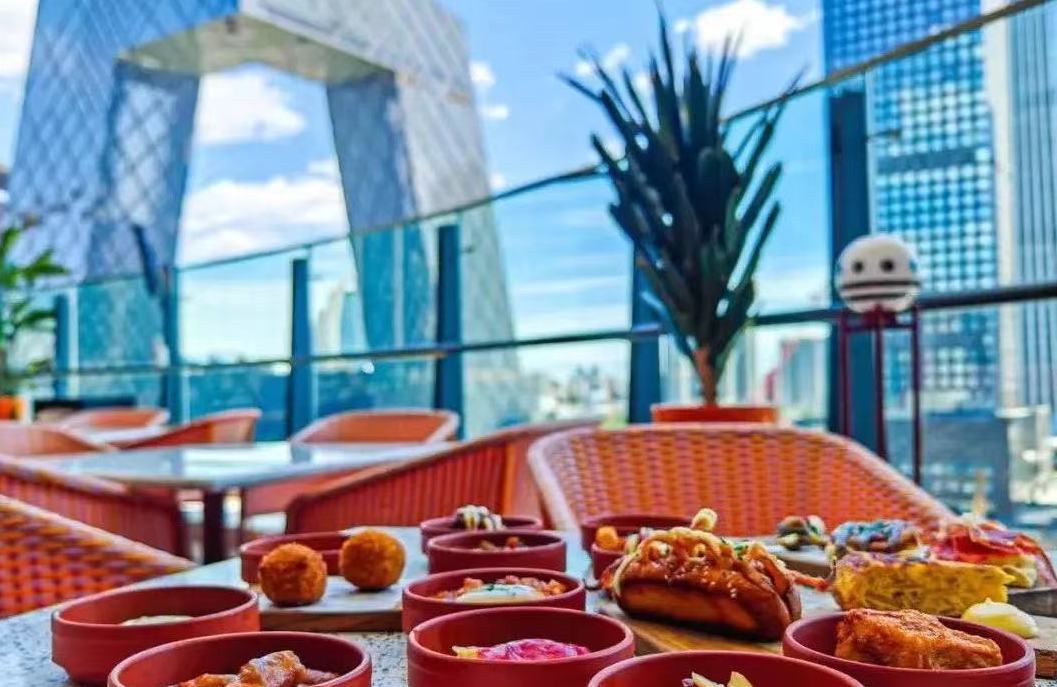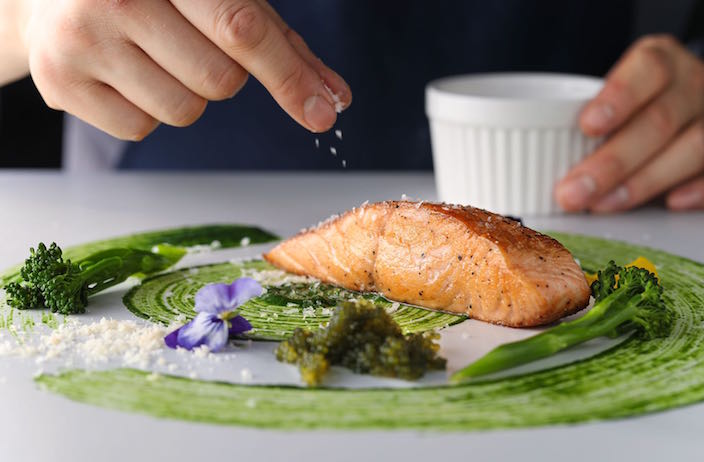Photos by Holly Li
Nathan Zhang is pretty upset right now.
Workers hired by his local authorities are chipping away at his restaurant. Literally. With chisels. They are replacing the hutong exterior with fresh gray cement, cut into rectangles to resemble bricks, as part of a mianzi gongchen, or ‘face project.’ Most other property renters in the area are happy with the free makeover. But Nathan doesn’t want a new face.
On one of my visits, he darts in and out of his front door, watching the workers nervously and shaking his head. And on another, he gives the workers outside a stern talking to before allowing them to continue and joining me for tea.
“That side of the building belongs to my neighbor, so I can’t do anything,” he explains, gesturing with an air of resignation toward the space to the right of his front door. “But they can’t touch the rest – that’s mine. I’ll fight it.”
On Xiang’er Hutong, noodle joints and chuan’r shops stretch all the way from Beixinqiao to Jiaodaokou Nan, and they mostly look the same. Nathan’s place, White Tiger Village, is indeed a chaun’r joint. But it doesn’t look like the others. It stands out.
Earlier this year, Nathan began work on his restaurant, which serves Dongbei comfort foods alongside good wine and beer. And while his New Zealand lamb skewers are succulent, it’s the establishment’s unique design that may keep customers coming back.
With the help of his interior-designer friend Yvonne Lin, Nathan created an open-plan kitchen for his restaurant, the focal point of which is a large countertop: chefs chop and stir on one side, customers sit on stools on the other. The rest of the space is filled with two tall tables, surrounded by high chairs, which lend it a casual, almost bar-like vibe. And rather than a traditional hutong color scheme of gray and red, the place is peppered with lemon-yellow accents (“I always liked yellow,” says Nathan with a shrug).

But perhaps the best bit is the restaurant’s east wall, which displays different artworks every few months. Currently, a cartoon of a Dongbei police officer, created by Beijing T-shirt brand Plastered 8, looks down on the customers below.
White Tiger Village’s design is modern, fun and full of natural light. But not only that – it has fueled the restaurant’s success. And that’s exactly why Nathan’s not happy about forced renovations.
“Why do we all have to look the same?” he laments.
This is a question many food and drink entrepreneurs are asking lately. For years, Beijing restaurants have largely looked the same. Stroll any residential area and you’ll pass local restaurants whipping up dishes under glaring fluorescent light, and tables lined up in a grid. You’ll pass logos in the same colors and fonts. You’ll pass waitresses dressed in similar uniforms, handing you identical laminated menus.
This sameness may be a hangover from 60s- and 70s-era communist ideals, which encouraged aesthetics of uniformity. But today, a growing number of the city’s restaurateurs are using thoughtful, individualistic design to make their places stand out.
In short: dining and designing are no longer separate things.
A case in point is 10 Corso Como, seemingly light-years away from the hutongs of Dongcheng in Dawang Lu’s ritzy Shinkong Place. The design-house and restaurant from Milan opened its Beijing cafe last month, and when I ask for directions there, marketing manager Rekky Liu sends me a cheerful WeChat voice message: “We’re in front of Armani and next to Chanel!”
Shinkong Place is, after all, crammed with more high-end designer brands than a celebrity’s walk-in shoe closet. And 10 Corso Como’s new cafe is no exception. It’s certainly glamorous enough to sit comfortably among its fashion-house neighbors. But it also manages to stand out.
 Photo provided by 10 Corso Como
Photo provided by 10 Corso Como
Inside the cafe, gorgeous tiles, hand-painted by American artist Kris Ruhs to resemble teacup saucers, line the walls. (“Do you go to Milan for fashion week?” Ruhs asks me over Prosecco later, as if that’s something I might regularly, you know, do.)
Ironically, it’s the members of the crowd assembled for the cafe’s opening party (a spectacle of performance art executed entirely with food) that all look the same. Almost everyone is dressed in chic black. I didn’t get the memo, sorry guys.
The brand has already flown in Michelin-starred chefs for exclusive dining events, something the 10 Corso Como team plans to continue. The success of the cafe, which established locations in Shanghai, Seoul and Milan before opening in Beijing, suggests that the current trend of incorporating creative design into dining spaces may form at high-end establishments before filtering down to the mass market.
But the hutongs suggest otherwise. Popular Gulou cafe Zarah has expanded its offerings beyond the caffeine needs of laptop-warriors by displaying art exhibitions on its walls (part of the semi-recent renovations that rendered its design sleek and beautiful). Great Leap Brewing #6 recently completed a renovation combining modern comforts and practicalities with a delightfully preserved traditional hutong aesthetic (as we profiled in last month’s That’s Beijing). Dashilar’s Spoonful of Sugar, meanwhile, is essentially a study in mindful gentrification. The two-story space is airy and full of natural light – but it also features an eco-friendly roof garden and hosts community events.
The annoyingly stylish Shanghai is also putting more thought into aesthetics, according to restaurant designer Briar Hickling, who has worked on some of the most famous F&B spaces in China, including celebrity chef Jason Atherton’s Table No. 1. More recently, she partnered with a Swedish-Chinese architect friend to launch a design studio, Linehouse, which has worked on some of the most high-profile restaurants and cafes in Shanghai.
“With design, you can create a story, a narrative,” she explains. “You can make your food and your design have a sort of relationship.”
As a trained theater set designer – Briar worked with The Arts Foundation of New Zealand before moving to China seven years ago – she says she prefers designing restaurant spaces because she can “make rituals ‘performative’.”
“You can frame certain moments through the use of architecture to give the diner a heightened experience,” she says.
For a recent Linehouse project, a baozi shop in Shanghai called Baoism, Briar reinterpreted the ancient Chinese text of I-Ching to create modern custom lights with historical significance – the lines of lights on the ceiling represent the yarrow twigs that people tossed when consulting the I-Ching.
 Photo provided by Linehouse
Photo provided by Linehouse
It’s inspired, creative and distinctly modern. But why is all this restaurant design work only booming now? Some credit the growth of international influences. A number of uniquely designed restaurant spaces are foreign-owned (10 Corso Como, for example, is Italian, and although Nathan is Chinese, he spent much of his life abroad in Canada).
This isn’t to say that local restaurant aesthetics are inherently low-brow. In imperial times, banquet halls were splendid and ornate – something that you can still find today in places like Beihai Park’s Fangshan Restaurant, although they’ve often been overly gussied for tourists.
During the first few decades of the People’s Republic, however, such decadence was not tolerated. But since then, aesthetics have changed. And perhaps more importantly, the economy has changed, too.
“It’s not even a trend, you just have to now,” says Nathan of good design. After all, the motivation to create a beautiful restaurant space isn’t purely aesthetic – it’s good business. “There are so many good places now, you have to make your place more and more unique, otherwise there’s no point. I think every single restaurant needs to have its own character.
“If you want to open a restaurant right now in Beijing, it’s such a competitive market.”
But while this competitive market may be tough for restaurateurs, it’s benefiting us, the diners. Graphic designer Christopher Waters is one such diner. Waters started Design and Dine to bring designers together to chat informally over meals in creative-minded spaces, or, as he says with a laugh: “places like The Smokeyard that just have really good food.”
If you are, after all, taking time to appreciate good food, it would appear, you might as well be appreciating good aesthetics too.
“Your experience includes eating, smelling, seeing, listening – all different senses. Altogether, they create the whole experience. Together, you have a memory,” says Nathan.
Positive memories, of course, are what drive customers to return to certain restaurants. But economics aside, memories on their own are pretty sweet. As Briar puts it: “The most rewarding part is sitting in the space after it’s completed and watching people enjoy it.”
I, however, disagree. I’d argue the most rewarding part of all this is sitting in the space after it’s completed – and being the person enjoying it.






















0 User Comments